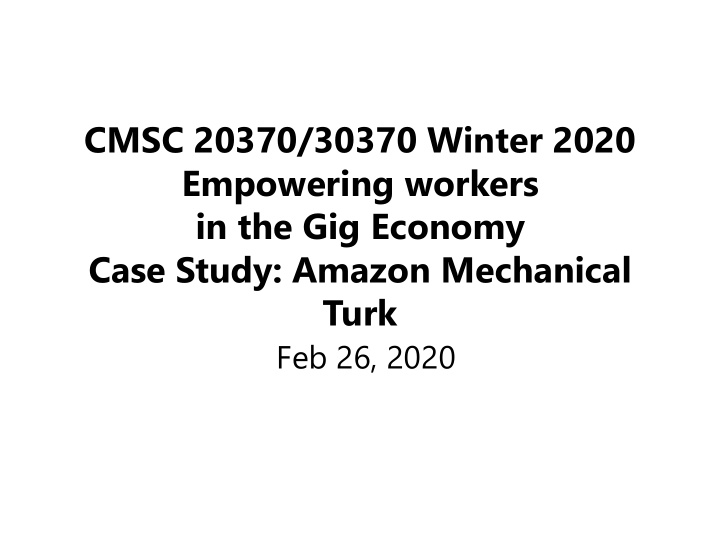



CMSC 20370/30370 Winter 2020 Empowering workers in the Gig Economy Case Study: Amazon Mechanical Turk Feb 26, 2020
Quiz Time (5-7 minutes). Quiz on Turkopticon Principles of Good Design
Administrivia • GP3 prototype testing session on Friday • GP3 due on Monday
Today’s Agenda • Gig Economy • Case Study: Turkopticon
Case Study: Turkopticon • Focus on Amazon Mechanical Turk platform for crowdworkers • Felt that the platform was not protecting workers • Developed a worker’s bill of rights • Created Turkopticon system to allow workers to rate employees and see others reviews • Discuss the system and outline design implications for activists systems
What is the gig economy? • Basically refers to people getting short term engagements, temporary contracts, or doing independent contracting • “gigs” • Also called sharing economy, freelancer economy, agile workforce, independent workforce • One gig is only a small fraction of workers income • Worker has to accumulate many gigs to earn a full time income
How does the gig economy operate? • Many different platforms for connecting workers looking for flexible work conditions to employers
Benefits • Flexible hours • Can do challenging projects • Can build up skill sets • Do not need skills in many cases • Work from anywhere as long as you have internet connection
Cons • Temporary • No benefits packages • Easier to be exploited • Can develop health issues related to repetitive tasks (e.g. Amazon warehouse)
Why does this work?
What is Amazon Mechanical Turk?
What is an example HIT? • A HIT is a human intelligence task
Are there competing platforms to AMT?
AMT in Research
AMT use is broader than HCI/CS
Why is AMT problematic? • Workers can be denied payment for tasks • Workers cannot negotiate with requesters • Lots of work for not much money • Can be discrimination (approval rating, location) • Sometimes exposed to unethical/illegal tasks
What does Turkopticon do?
How did they create it? • Created a HIT for worker’s bill of rights • Had to seed the system with reviews • Used HIT to seed the system
Why did they create it? • Help with transparency • Give workers a voice • Ensure that unfair requesters or questionable requesters are outed • Any issues with current implementation?
Is it missing any features? • What about voice of requesters? • Also, later moved to user ids instead of obscured email addresses
What are the design implications from Turkopticon? • Keeping up with changing interface of AMT • Tactical quantification – E.g. what is “generosity”?, different people have different scales • Creating public where workers can engage even in absence of physical office • Success but also supporting system that is potentially exploiting people
Turkopticon 2 – review HITS
Alternatives? • Build other worker-friendly platforms • Create tools to augment existing platforms • Offer legal protections • ? • Any changes to UCD for this work?
SIGCHI #HCIxCooperativism
Summary • Gig economy has really taken off • Workers benefit but also face exploitation • How to ensure fair environment for workers? • Creating publics for workers to engage and have more transparency can help • Regulation plays a part but can also create systems to give workers agency • The crowd is a wonderful resource but a crowd is made up of people
Coming up… • GP3 prototype due on Friday • GP3 report due on Monday
Get in touch: Office hours: Fridays 2-4pm (Sign up in advance) or by appointment JCL 355 Email: marshini@uchicago.edu
Recommend
More recommend